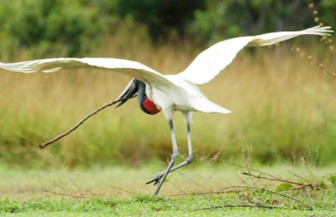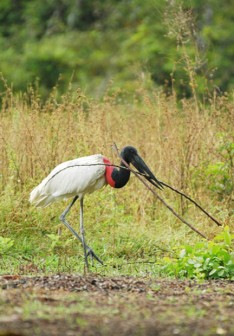The Jabiru Stork (Jabiru mycteria) is the tallest (122-40 cm) flying bird in South and Central America and belongs to the stork family, Ciconiidae.

These stately white-bodied birds wear a black beak and neck and a bright red ‘collar’ at the base of their necks. They can be seen on sandbanks of rivers and in swamps of the Iwokrama Forest and North Rupununi, and are a common sight in flooded savannah lands in the wet season, picking their way with their long legs looking for fish, amphibians, frogs and molluscs. Ungainly on the ground, they rattle their beaks when alarmed and take off with great swooping strides.
Once in the air, they are graceful flyers with a wingspan of between 230 and 280 cm.
Males and females look alike and nesting takes place at the beginning of the dry season, when ponds and wetlands are drying and food for the young is abundant. Jabiru Storks build large nests of sticks in emergent trees on river banks or near wetlands, often in Silk Cotton (Ceiba) trees and will often return to old nests year after year.

Two or three fluffy heads of young storks can often be seen poking their heads from rough nests and then venturing out onto the limbs of the home tree. Once fledged, they will forage on their own, their red collars becoming darker and more vibrant as they reach maturity.
Rain forests are rich in biodiversity and are home to many different plants and animals as well as for indigenous communities. Even if you don’t live in the rain forest, humans rely on the forest for resources such as building materials (wood and lianas), medicine and fruits. Rain forests produce also provide essential environmental services for life on earth; they create soil as well as prevent soil erosion, produce oxygen though photosynthesis, maintain clean water systems, and are a key defence against climate change.
The Iwokrama Rain Forest is 371,000 hectares, located in the heart of Guyana. Our mission is to develop strategies for conservation and sustainable development for local people in Guyana and the world at large. We are involved in tourism, training, research and our timber is certified by the Forest Stewardship Council. Come and visit us in the rain forest or at http://www.iwokrama.org.





